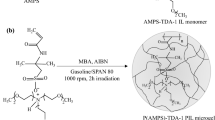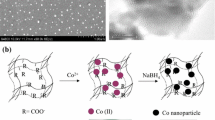Abstract
First approach towards in situ synthesis of iron (Fe) nanoparticles within poly(N-isopropylacrylamide-acrylic acid) (p(NIPAM-AA)) microgel is established in this work. Morphology, size, and size distribution of Fe-p(NIPAM-AA) hybrid microgel are confirmed by FTIR, STEM, and UV-Vis spectroscopy. Size of majority of Fe nanoparticles lies in 5–25-nm range, and very few nanoparticles lie in 30–40-nm range. Reduction of series of substrates with similar and dissimilar chemical structure is catalyzed by synthesized Fe-p(NIPAM-AA) hybrid microgel. Catalytic activity of hybrid microgel towards various substrates is studied by comparing their apparent rate constant (kapp), reduction time, and percentage reduction. Catalytic activity of hybrid microgel towards reduction of nitroarenes is observed higher than that of azo dyes. Repulsion among carboxyl groups (COOH) of AA facilitated the flux of substrates inside the microgel network. Significant difference among kapp, reduction time, and percentage reduction of all substrates is observed. kapp of crystal violet is observed maximum among all substrates. Percentage conversion of 4-nitroanisole is observed highest among all substrates. Similar values of kapp, reduction time, and reduction percentage of all nitrophenols are obtained, while significant difference in values of kapp, reduction time, and reduction percentage of all azo dyes is observed. Catalytic reduction of all substrates is compared on the basis of orientation of functional groups, presence of bulky groups, and number of bonds to be reduced.

Graphical abstract




Similar content being viewed by others
References
Abid HR, Shang J, Ang H-M, Wang S (2013) Amino-functionalized Zr-MOF nanoparticles for adsorption of CO2 and CH4. Int J Smart Nano Mater 4:72–82
Bhattacharjee A, Ahmaruzzaman M, Sinha T (2015) A novel approach for the synthesis of SnO2 nanoparticles and its application as a catalyst in the reduction and photodegradation of organic compounds. Spectrochim Acta Part A Mol Biomol Spec 136:751–760
Bhattacharya S, Eckert F, Boyko V, Pich A (2007) Temperature, pH, and magnetic-field -sensitive hybrid microgels. Small 3:650–657
Biffis A, Cunial S, Spontoni P, Prati L (2007) Microgel-stabilized gold nanoclusters: powerful “quasi-homogeneous” catalysts for the aerobic oxidation of alcohols in water. J Catal 251:1–6
Calace N, Nardi E, Petronio B, Pietroletti M (2002) Adsorption of phenols by papermill sludges. Environ Pollut 118:315–319
Chang PR, Yu J, Ma X, Anderson DP (2011) Polysaccharides as stabilizers for the synthesis of magnetic nanoparticles. Carbohydr Polym 83:640–644
Chen T, Fang Q, Zhou L, Xu Z, Qiu J, Wang M, Wang J (2019) Comparative study of cross-linked and linear thermo-responsive carriers supported palladium nanoparticles in the reduction of 4-nitrophenol: structure, catalytic activity and responsive catalysis property. React Func Polym 142:104–111
Dong Z, Le X, Li X, Zhang W, Dong C, Ma J (2014) Silver nanoparticles immobilized on fibrous nano-silica as highly efficient and recyclable heterogeneous catalyst for reduction of 4-nitrophenol and 2-nitroaniline. Appl Catal B Environ 158:129–135
Edison TJI, Sethuraman M (2013) Biogenic robust synthesis of silver nanoparticles using Punica granatum peel and its application as a green catalyst for the reduction of an anthropogenic pollutant 4-nitrophenol. Spectrochim Acta Part A Mol Biomol Spec 104:262–264
Eslami S, Ebrahimzadeh MA, Biparva P (2018) Green synthesis of safe zero valent iron nanoparticles by Myrtus communis leaf extract as an effective agent for reducing excessive iron in iron-overloaded mice, a thalassemia model. RSC Adv 8:26144–26155
Farooqi ZH, Khan SR, Hussain T, Begum R, Ejaz K, Majeed S, Ajmal M, Kanwal F, Siddiq M (2014) Effect of crosslinker feed content on catalaytic activity of silver nanoparticles fabricated in multiresponsive microgels. Korean J Chem Eng 31:1674–1680
Farooqi ZH, Naseem K, Begum R, Ijaz A (2015a) Catalytic reduction of 2-nitroaniline in aqueous medium using silver nanoparticles functionalized polymer microgels. J Inorg Organomet Polym Mater 25:1554–1568
Farooqi ZH, Sakhawat T, Khan SR, Kanwal F, Usman M, Begum R (2015b) Synthesis, characterization and fabrication of copper nanoparticles in N-isopropylacrylamide based co-polymer microgels for degradation of p-nitrophenol. Mater Sci Poland 33:185–192
Fu Y, Xu P, Huang D, Zeng G, Lai C, Qin L, Li B, He J, Yi H, Cheng M (2019) Au nanoparticles decorated on activated coke via a facile preparation for efficient catalytic reduction of nitrophenols and azo dyes. Appl Surf Sci 473:578–588
Ghosh BK, Hazra S, Naik B, Ghosh NN (2015) Preparation of Cu nanoparticle loaded SBA-15 and their excellent catalytic activity in reduction of variety of dyes. Powder Technol 269:371–378
Huang X, El-Sayed MA (2010) Gold nanoparticles: optical properties and implementations in cancer diagnosis and photothermal therapy. J Adv Res 1:13–28
Hudson R, Ishikawa S, Li CJ, Moores A (2013) Magnetically recoverable CuFe2O4 nanoparticles as highly active catalysts for Csp3–Csp and Csp3–Csp3 oxidative cross-dehydrogenative coupling. Syn Lett 24:1637–1642
Ismail M, Khan M, Khan SB, Akhtar K, Khan MA, Asiri AM (2018) Catalytic reduction of picric acid, nitrophenols and organic azo dyes via green synthesized plant supported Ag nanoparticles. J Mol Liq 268:87–101
Karg M, Pastoriza-Santos I, Rodriguez-Gonzalez B, von Klitzing R, Wellert S, Hellweg T (2008) Temperature, pH, and ionic strength induced changes of the swelling behavior of PNIPAM− poly (allylacetic acid) copolymer microgels. Langmuir 24:6300–6306
Khan SR, Farooqi ZH, Waheed uz Z, Ali A, Begum R, Kanwal F, Siddiq M (2016) Kinetics and mechanism of reduction of nitrobenzene catalyzed by silver-poly(N-isopropylacryl amide-co-allylacetic acid) hybrid microgels. Mater Chem Phys 171:318–327
Liu YY, Liu XY, Yang JM, Lin DL, Chen X, Zha LS (2012) Investigation of Ag nanoparticles loading temperature responsive hybrid microgels and their temperature controlled catalytic activity. Colloid Surf A 393:105–110
Martinez-Huitle CA, Ferro S (2006) Electrochemical oxidation of organic pollutants for the wastewater treatment: direct and indirect processes. Chem Soc Rev 35:1324–1340
Naseem K, Begum R, Farooqi ZH (2018) Platinum nanoparticles fabricated multiresponsive microgel composites: synthesis, characterization, and applications. Polym Compos 39:2167–2180
Ott WR, Roberts JW (1998) Everyday exposure to toxic pollutants. Sci Am 278:86–91
Pawar RC, Khare V, Lee CS (2014) Hybrid photocatalysts using graphitic carbon nitride/cadmium sulfide/reduced graphene oxide (gC3N4/CdS/RGO) for superior photodegradation of organic pollutants under UV and visible light. Dalton Trans 43:12514–12527
Pich A, Karak A, Lu Y, Ghosh AK, Adler HJP (2006a) Tuneable catalytic properties of hybrid microgels containing gold nanoparticles. J Nanosci Nanotechnol 6:3763–3769
Pich A, Karak A, Lu Y, Ghosh AK, Adler HJP (2006b) Preparation of hybrid microgels functionalized by silver nanoparticles. Macromol Rapid Commun 27:344–350
Pouretedal H, Sabzevari S (2011) Photodegradation study of Congo red, methyl orange, methyl red and methylene blue under simulated solar irradiation catalyzed by ZnS/CdS nanocomposite. Desalin Water Treat 28:247–254
Sarkar S, Banerjee A, Halder U, Biswas R, Bandopadhyay R (2017) Degradation of synthetic azo dyes of textile industry: a sustainable approach using microbial enzymes. Water Cons Sci Eng 2:121–131
Shah LA, Haleem A, Sayed M, Siddiq M (2016) Synthesis of sensitive hybrid polymer microgels for catalytic reduction of organic pollutants. J Environ Chem Eng 4:3492–3497
Shahid M, Farooqi ZH, Begum R, Arif M, Wu W, Irfan A (2019) Hybrid microgels for catalytic and photocatalytic removal of nitroarenes and organic dyes from aqueous medium: a review. Crit Rev Anal Chem:1–25. https://doi.org/10.1080/10408347.2019.1663148
Shi X, Wang SH, Swanson SD, Ge S, Cao Z, Van Antwerp ME, Landmark KJ, Baker JR Jr (2008) Dendrimer-functionalized shell-crosslinked iron oxide nanoparticles for in-vivo magnetic resonance imaging of tumors. Adv Mater 20:1671–1678
Soğukömeroğulları HG, Karataş Y, Celebi M, Gülcan M, Sönmez M, Zahmakiran M (2019) Palladium nanoparticles decorated on amine functionalized graphene nanosheets as excellent nanocatalyst for the hydrogenation of nitrophenols to aminophenol counterparts. J Hazard Mater 369:96–107
Ulbrich K, Hola K, Subr V, Bakandritsos A, Tucek J, Zboril R (2016) Targeted drug delivery with polymers and magnetic nanoparticles: covalent and noncovalent approaches, release control, and clinical studies. Chem Rev 116:5338–5431
Veerakumar P, Chen SM, Madhu R, Veeramani V, Hung CT, Liu SB (2015) Nickel nanoparticle-decorated porous carbons for highly active catalytic reduction of organic dyes and sensitive detection of Hg (II) ions. ACS Appl Mater Interf 7:24810–24821
Velayudhan Nair Girija V, Vasu S (2019) Synthesis and characterization of iron oxide nanoparticles by thermal decomposition method of iron (III) chelates. Int J Nanosci Nanotechnol 15:65–73
Wang J, Chen B (2015) Adsorption and coadsorption of organic pollutants and a heavy metal by graphene oxide and reduced graphene materials. Chem Eng J 281:379–388
Wu W, Shen J, Li Y, Zhu H, Banerjee P, Zhou S (2012) Specific glucose-to-SPR signal transduction at physiological pH by molecularly imprinted responsive hybrid microgels. Biomaterials 33:7115–7125
Wunder S, Lu Y, Albrecht M, Ballauff M (2011) Catalytic activity of faceted gold nanoparticles studied by a model reaction: evidence for substrate-induced surface restructuring. ACS Catal 1:908–916
Yamjala K, Nainar MS, Ramisetti NR (2016) Methods for the analysis of azo dyes employed in food industry–a review. Food Chem 192:813–824
Yoo SI, Kwon JH, Sohn BH (2007) Single layers of diblock copolymer micelles for the fabrication of arrays of nanoparticles. J Mater Chem 17:2969–2975
Zhang Y, Zhang J, Cheng Z, Xu J (2011) Morphology dependence effect of CuO nanostructures on their Cl2 sensing properties. Sens Lett 9:175–178
Acknowledgments
All authors are grateful to Department of Chemistry, University of Agriculture, Faisalabad, Pakistan.
Author information
Authors and Affiliations
Corresponding author
Ethics declarations
Conflict of interest
The authors declare that they have no conflict of interest.
Additional information
Publisher’s note
Springer Nature remains neutral with regard to jurisdictional claims in published maps and institutional affiliations.
Rights and permissions
About this article
Cite this article
Khan, S.R., Ali, S., Ullah, B. et al. Synthesis of iron nanoparticles in poly(N-isopropylacrylamide-acrylic acid) hybrid microgels for catalytic reduction of series of organic pollutants: a first approach. J Nanopart Res 22, 192 (2020). https://doi.org/10.1007/s11051-020-04924-5
Received:
Accepted:
Published:
DOI: https://doi.org/10.1007/s11051-020-04924-5




